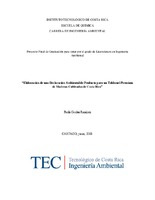Mostrar el registro sencillo del ítem
Elaboración de una declaración ambiental de producto para un Tablamel Premium de Maderas Cultivadas de Costa Rica
| dc.contributor.author | Cerdas-Ramírez, Paola | |
| dc.date.accessioned | 2018-08-07T22:08:39Z | |
| dc.date.available | 2018-08-07T22:08:39Z | |
| dc.date.issued | 2018 | |
| dc.identifier.uri | https://hdl.handle.net/2238/9871 | |
| dc.description | Proyecto de Graduación (Licenciatura en Ingeniería Ambiental) Instituto Tecnológico de Costa Rica, Escuela de Química, 2018 | es |
| dc.description.abstract | The implementation of policies for the mitigation of climate change promotes the use of environmental strategies to obtain products with greater sustainability. In the case of the European Union (EU), by 2020 it is required that all exported products present an Environmental Product Declaration (EPD). In Costa Rica, 25,1% of total timber production is due to the construction sector and 18,9% to exportation of raw and sawed timber, which implies that the country requires the development of technical capacities for the preparation of EPD. For the elaboration of the EPD, a Life Cycle Analysis (LCA) was required, for which the methodology stipulated by ISO 14025, ISO 14040, ISO 14044 and the Product Category Rule (PCR) for products of wood for structural and architectural use for North America A CPC 31-NAICS 321 were followed. The scope defined for the LCA was from the cradle to the gate considering the life cycle stages of seedling production, forestry operations, wood processing and transportation to the point of sale. The results of the DAP to produce a Premium Wooden Panel in Maderas Cultivadas de Costa Rica were 10,6 kg CO2 eq for climate change potential, 0,016 kg SO2 eq for acidification, 0,00082 kg N eq for eutrophication, 0,011 kg NMVOC for potential of formation of photochemical oxidants, 5,33 E-07 kg CFC-11 eq for depletion of the ozone layer, 0,036 m3 for water depletion potential and a total primary energy consumption of 100,47 MJ. It was determined that the environmental hot spots were the intensive use of nitrogen fertilizers, the production of heat for drying process, electricity consumption and the use of diesel. The carbon fixation in the finished product showed a result of 41,76 kg CO2 which allows a differentiation in the market in contrast with alternative materials for construction. The comparison with other studies indicated that there is no similarity in the impact of environmental impact per stage of the life cycle, except for the carbon footprint. The main challenge identified for the elaboration of eco-labels in the forestry sector was that there is no market that requests the demand for wood products with environmental quality certificates for which the economic feasibility for implementation is zero. | es |
| dc.description.sponsorship | Maderas Cultivadas de Costa Rica | es |
| dc.language.iso | spa | es |
| dc.publisher | Instituto Tecnológico de Costa Rica | es |
| dc.rights | acceso abierto | es |
| dc.subject | Análisis | es |
| dc.subject | Ciclo | es |
| dc.subject | Cambio | es |
| dc.subject | Sostenibilidad | es |
| dc.subject | DAP | es |
| dc.title | Elaboración de una declaración ambiental de producto para un Tablamel Premium de Maderas Cultivadas de Costa Rica | es |
| dc.type | proyecto de fin de carrera | es |


